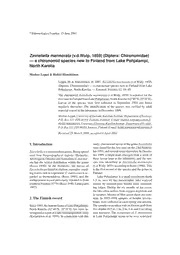
Zavreliella marmorata (v.d.Wulp, 1859) (Diptera: Chironomidae) — a chironomid species new to Finland from Lake Pohjalampi, North Karelia PDF
Preview Zavreliella marmorata (v.d.Wulp, 1859) (Diptera: Chironomidae) — a chironomid species new to Finland from Lake Pohjalampi, North Karelia
4© 4Entomologica Fennica. 15 June 2001 Leppä & Hämäläinen • ENTOMOL. FENNICA Vol. 12 Zavreliella marmorata (v.d.Wulp, 1859) (Diptera: Chironomidae) — a chironomid species new to Finland from Lake Pohjalampi, North Karelia Markus Leppä & Heikki Hämäläinen Leppä, M. & Hämäläinen, H. 2001: Zavreliella marmorata (v.d.Wulp, 1859) (Diptera: Chironomidae) — a chironomid species new to Finland from Lake Pohjalampi, North Karelia. — Entomol. Fennica 12: 44–45. The chironomid Zavreliella marmorata (v.d.Wulp, 1859) is reported for the first time in Finland from Lake Pohjalampi, North Karelia (62°40´N, 29°33´E). Larvae of the species were first collected in September 1993 and found regularly thereafter. The identification of the species was verified by adult material reared in the laboratory in December 1999. Markus Leppä, University of Joensuu, Karelian Institute, Department of Ecology, P.O. Box 111, FIN-80101 Joensuu, Finland; E-mail: [email protected] Heikki Hämäläinen, University of Joensuu, Karelian Institute, Department of Ecology, P.O. Box 111, FIN-80101 Joensuu, Finland; E-mail: [email protected] Received 28 March 2000, accepted 4 April 2001 1. Introduction study, chironomid larvae of the genus Zavreliella were found for the first time on the 23rd Septem- Zavreliella is a cosmopolitan genus. Being spread ber 1993, and several times thereafter. In Decem- over four biogeographical regions (Holarctic, ber 1999, a single male emerged from a stock of Afrotropical, Oriental and Australian) Z. marmor- these larvae kept in the laboratory, and the spe- ata has the widest distribution within the genus cies was identified as Zavreliella marmorata (Reiss 1990). In the Holarctic, the larvae of (v.d.Wulp, 1859) according to Reiss (1990). This Zavreliella are found in shallow, eutrophic stand- is the first record of the species and the genus in ing waters rich in vegetation. Z. marmorata is re- Finland. garded as thermophilous (Reiss 1990), and the Lake Pohjalampi is a small (maximum depth northernmost record previously reported is from 5.3 m, area 61 ha) mesotrophic lake watered southern Sweden (57°N) (Reiss 1990, Lindegaard mainly by nutrient-poor brooks from surround- 1997). ing ridges. During the six months of ice cover, the lake often suffers from oxygen depletion and in summer, blooms of blue-green algae are com- 2. The Finnish record mon. In 1993–1998 samples of benthic inverte- brates were collected in each spring and autumn. Since 1993, the bottom fauna of Lake Pohjalampi, The samples were taken with an Ekman-grab from North Karelia (62°40´N, 29°33´E) has been in- five depths (0.5 m, 1 m, 2 m, 3 m and 4 m) along vestigated as a part of a lake biomanipulation study nine transects. The occurrence of Z. marmorata (Karjalainen et al. 1999). In connection with this in Lake Pohjalampi seems to be very restricted. ENTOMOL. FENNICA Vol.12 • Zavreliella marmorata — a species new to Finland 45 Despite effective sampling the species has only transportable case, which is laterally flattened and been found from one location, close to the shore constricted at the ends. Amongst Holarctic at a depth of 0.5–1 m. The soft, muddy sediment Chironomini the last two features mentioned are was largely covered by dead leaves, mainly from found together only in Zavreliella and Lauter- alder (Alnus incana (L.)). Aquatic vegetation at borniella. Zavreliella differs from Lauterborniella the site was scarce, although Zavreliella has been e.g. by a circular opening of the case, long lateral mentioned to favour rich submerged vegetation tubules and simple seta subdentalis and setae (Pinder & Reiss 1983). submenti (Pinder & Reiss 1983). 3. Discussion References The climate in the main distribution area of Karjalainen, J., Leppä, M., Rahkola, M. & Tolonen, K. T. Zavreliella marmorata is clearly milder than that 1999: The role of benthivorous and planktivorous fish of eastern Finland. Thus, the present occurrence in a mesotrophic lake ecosystem. — Hydrobiologia 408/ 409: 73–84. of Z. marmorata in Lake Pohjalampi may be a Lindegaard, C. 1997: Diptera Chironomidae, non-biting relic from the Holocene Warm period. A shel- Midges. — In Nilsson, N.A (ed.), Aquatic Insects of tered location and relatively warm (3–6 °C) spring North Europe. A Taxonomic Handbook. Apollo Books. water entering the lake via brooks or from dis- Stenstrup, Denmark. 440 pp. crete springs below the surface throughout the year Pinder, L.C.V. & Reiss, F. 1983: The larvae of may have allowed the species to persist in the lake. Chironominae (Diptera: Chironomidae) of the Holarctic region — Keys and diagnoses. — Ent. Scand. Suppl. The larvae of Zavreliella are relatively easy 19: 293–435. to recognize. They are small (4–6 mm) and pale Reiss, F. 1990: Revision der Gattung Zavreliella Kieffer, to dark red in colour. They have a large, anteriorly 1920 (Diptera, Chironomidae). — Spixiana 13: 83– directed dorsal hump on the 11th segment and a 115.
